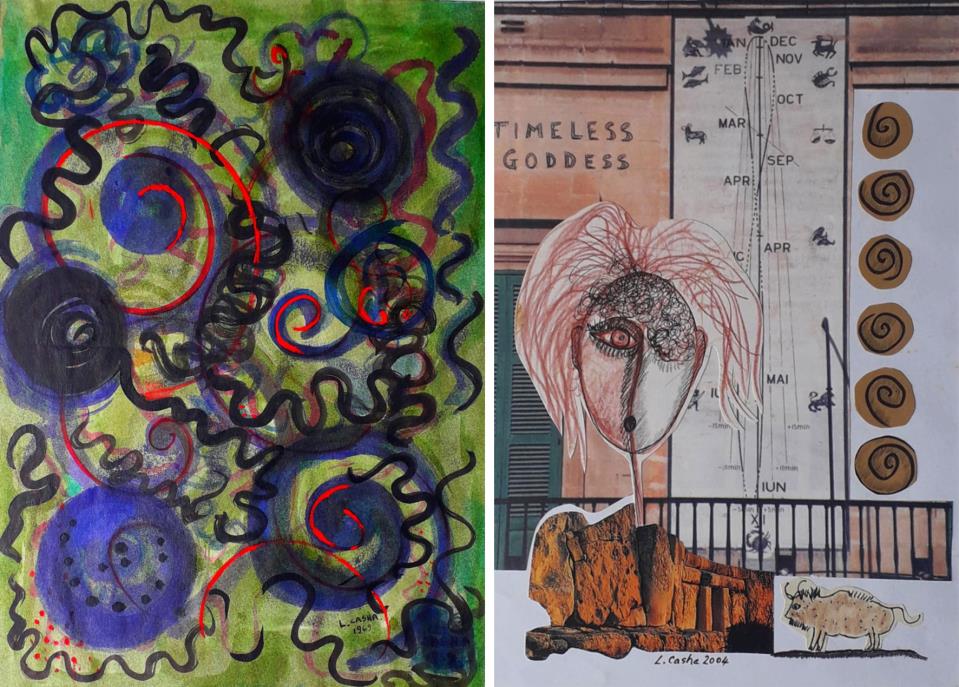When discussing the work of veteran contemporary artist Louis Casha, one is immediately drawn to his geometric forms and his exploration of the symbolic language of Neolithic art. Casha skilfully combines geometric elements found on Maltese Neolithic pottery and artefacts with the visual language of Op Art.
Coming from a family of artists, Casha is the brother of the late George and Joseph Casha, both respected art teachers and practitioners. Louis is considered one of the few third-generation Maltese artists who, as early as the 1960s, was already experimenting with geometric motifs. His academic background in Maltese history and archaeology at the University of Malta significantly deepened his appreciation for prehistoric art, particularly its symbolic and aesthetic dimensions.

Left: A myriad of triangles in black, grey, and yellow, 2021. Right: Figure in yellow, 2023. (Photos Bryan Borg)
Artistic influence from Maltese prehistoric art and optical art
Casha's first solo exhibition was held at Gallerija Feniċi in Valletta in 1982.
In his early work, such as Spirals and Discs (1969), Casha was already demonstrating a clear influence from Malta's prehistoric heritage, particularly the geometric motifs found on Neolithic temples. These motifs were reinterpreted into modern compositions. The late art critic Emmanuel Fiorentino (19472008) wrote: "His is an art steeped basically in the full glow of patriotic sentiments nourished from an age when the idea of patriotism had not yet been dreamed of, but which was fully conscious at the same time of a pride in its religious buildings - both for its living deities and dead ancestors - and either erected above ground or scooped out of the earth's bowels."
Similarly, Professor Oliver Friggieri (1947-2020), writing in the brochure for Casha's first solo exhibition, observed: "Time is related to space, and movement, immediately associated with the image of a circle, is depicted both as a state of transformation and as a state of changelessness. Repetition is interpreted as innovation."
Through such reinterpretation, Casha discovered both his individuality and a cultural identity rooted in the Maltese landscape and history. Thematically and stylistically, his art became a bridge between past and present.
Casha's point of departure is the Neolithic geometric shape, which he brings into dialogue with a modern visual vocabulary, namely, Op Art. His work fuses prehistoric symbolism with the precise, optical dynamism of Op Art.
A pivotal moment in his development occurred during his visit to the 1968 Venice Biennale, where he encountered Bridget Riley's Op Art. This experience left a lasting impression. One of his most notable later works, Homage to Franz Liszt (2011), reflects this influence. The piece draws on the interplay between music and visual geometry. Inspired by the expressive complexity of Liszt's compositions, it merges Op Art, musical abstraction and rhythmic structure in a dynamic synthesis.
Casha's artistic journey is informed by both formal research and visual experimentation, making ancient symbols relevant to contemporary aesthetics. In Timeless Goddess (2004), for instance, he creates a layered collage that bridges Malta's prehistoric past with modern cultural references. At its centre is a surreal feminine figure, part deity, part modern persona, rooted in the stone temples of Malta but framed by images of traditional balconies and a zodiac calendar. The spirals on the right evoke fertility and regeneration, echoing Neolithic motifs, while the whimsical animal figure below adds a mythical dimension. This work speaks to the resilience of feminine archetypes, blending ancient spirituality with contemporary visual language to explore identity, temporality and place.

Left: Spirals and discs, 1969. Right: Timeless goddess, 2004. (Photos: Bryan Borg)
Childhood influence: The kaleidoscope effect
Following his 1986 exhibition Time and Space at the National Museum of Fine Arts in Valletta, Casha's repertoire evolved. His black-and-white geometric patterns gave way to abstract imagery inspired by the kaleidoscope, a childhood toy that had left a deep impression. From this point onwards, his work incorporated vibrant, colourful compositions that bridged childhood memory with prehistoric forms.
In A Myriad of Triangles in Black, Grey and Yellow (2021), Casha explores abstraction through sharp, interlocking triangles that evoke a dynamic, faceted surface. Though limited to a subdued palette, the work pulsates with tension and rhythm, reflecting both mathematical order and emotional resonance. The piece captures how memory and geometry can converge into a visual language that is both personal and universal. Dominic Cutajar described such works as "poetic fantasy", where subconscious, primal impulses meet the rigour of mathematical composition.
Recent work
Today, Casha continues to experiment with minimalist and symbolic forms inspired by his environment. This is evident in recent works such as Figure in Yellow (2023), which encapsulate both a continuation of earlier themes and a subtle transformation. His minimalist motifs remain grounded in prehistoric symbolism and Op Art; a form of visual archaeology and perceptual enquiry, but now carry a quieter urgency.
Casha's recent pieces are the result of a distilled, meditative engagement with his surroundings. Observing everyday textures like walls, shadows, natural patterns, he allows these impressions to inform his compositions. There is spontaneity in his process, though not impulsiveness; the works emerge as if from a poetic listening, rather than calculated planning.
In a world saturated with noise and excess, Casha's use of minimalism may be read as a kind of resistance, a quiet protest that privileges clarity, contemplation and presence. His art continues to resonate with timeless motifs while engaging dynamically with the here and now.
Casha is currently preparing a few solo exhibitions including a retrospective exhibition that spans his career from the 1960s to the present.
Professor Louis Laganà PhD (Lough) is an academic, curator and practising artist